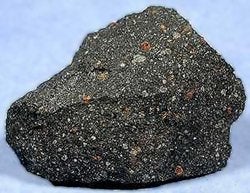The Independent's journalism is supported by our readers. When you purchase through links on our site, we may earn commission.
Scientist discover all ingredients necessary for DNA in meteorite for first time
While scientist have long known the precursors to life could form on asteroids, this is the first time they’ve found all the necessary ingredients for DNA

Exactly how regular matter first transmuted into the organised self-replicating assemblies of molecules that we call life on Earth is the focus of ongoing scientific research across many disciplines.
But a new paper published in the journal Nature Communications strengthens theories that hold the basis of life came from outer space.
Using new techniques of chemical analysis, Japanese researchers have now shown all the amino acids necessary to form DNA and RNA, the genetic basis of life can be found in small meteorites that fall to Earth.
These “nucleobases” are not examples of extraterrestrial life, but instead the result of chemistry taking place on asteroids while in space, which may then have seeded Earth with the necessary prebiotic material to help the development of life.
That material, the study authors write, may have “contributed to the emergence of genetic properties for the earliest life on Earth.”
The idea that genetic material could form on carbon-rich asteroids and then ride down to Earth on meteorites small enough to “soft-land” without vaporising the prebiotic material is not new and dates back at least 50 years.
In 1969, a meteorite landed in Murchison, Australia, and was found to contain many amino acids, suggesting interstellar chemistry could create the ingredients necessary for life. By the 1990s, planetary scientist Carl Sagan suggested that although the concentration of such organic material in each small meteorite is very small, the higher rate of meteorite impact seen in Earth’s youth could have led to a significant amount of material falling to our planet’s surface.
“The absolute abundance of nucleobases of extraterrestrial origin could be enough for further chemical reactions on the early Earth,” said Yasuhiro Oba, a professor in the Institute of Low Temperature Science at Hokkaido University, in Japan, and the lead author of the new study.
Scientists running simulations of the chemistry taking place on interstellar asteroids seemed to find more evidence supporting the idea that genetic material could form in space, according to Dr Oba. But studies of the Murchison and other meteorites, until now, only showed half of the necessary materials on the fallen space rocks.
DNA, which encodes the blueprint for each organism on Earth, and RNA, which communicates and implements that blueprint in each organism, are made up of two classes of molecules: the purines such as guanine and adenine, and the pyrimidines, such as cytosine, uracil, and thymine. DNA is constructed of adenine, guanine, cytosine, and thymine, the four nucleotides creating the base pairs of DNA, while RNA uses uracil in place of thymine.
But while previous studies had identified the purine nucleotides, guanine, and adenine, Dr Oga’s study is the first to discover the pyrimidines in meteorites, showing the full range of nucleotides necessary for genetic chemistry can, in fact, fall to Earth on space rocks.
What is not clear, however, is just how much of an impact on Earth’s early chemistry such meteorites may have had, and Dr Oba is quick to point out that a lot depends on how much prebiotic chemistry may have been active on Earth before considering any extraterrestrial influence.
“If the production efficiency of nucleobases on the Earth was much higher than the inputs from space,” he said, “contributions to the emergence of genetic function and/or life itself from such extraterrestrial nucleobases could not be large.”
At the same time, Dr Oba said, he believes it’s likely the prebiotic chemistry from multiple sources was important to the origins of life — it’s possible terrestrial and extraterrestrial chemistry made their own contributions.
Dr Oba and his colleagues made their discovery by training new technologies and techniques on three old meteorites, including the Murchison meteorite.
What excites him and his colleagues, they note in the paper, is the opportunity to apply new techniques to new asteroid samples extracted in space, such as from the Nasa mission currently returning samples from asteroid Bennu, and samples from asteroid Ryugu returned by the Japanese Space Agency in December 2020.
Such samples they write, “will provide us with important insights into the evolution of extraterrestrial organic molecules, and potential clues regarding the origins of life on Earth through chemical analyses of pristine extraterrestrial materials that have not been significantly compromised by terrestrial contamination. “
Subscribe to Independent Premium to bookmark this article
Want to bookmark your favourite articles and stories to read or reference later? Start your Independent Premium subscription today.

Join our commenting forum
Join thought-provoking conversations, follow other Independent readers and see their replies